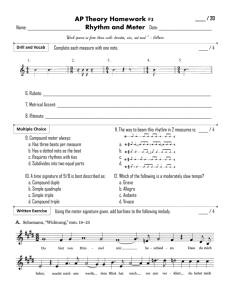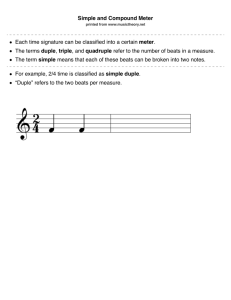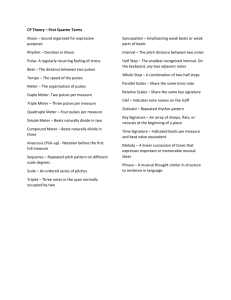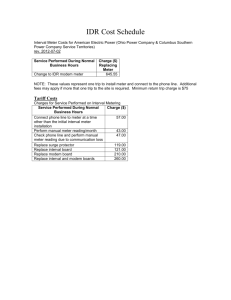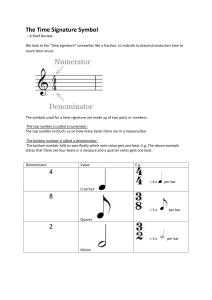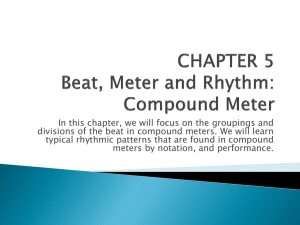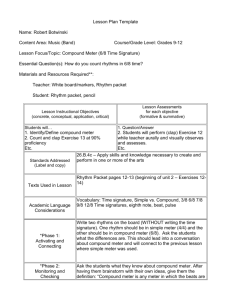Key for Practice Test #1
advertisement
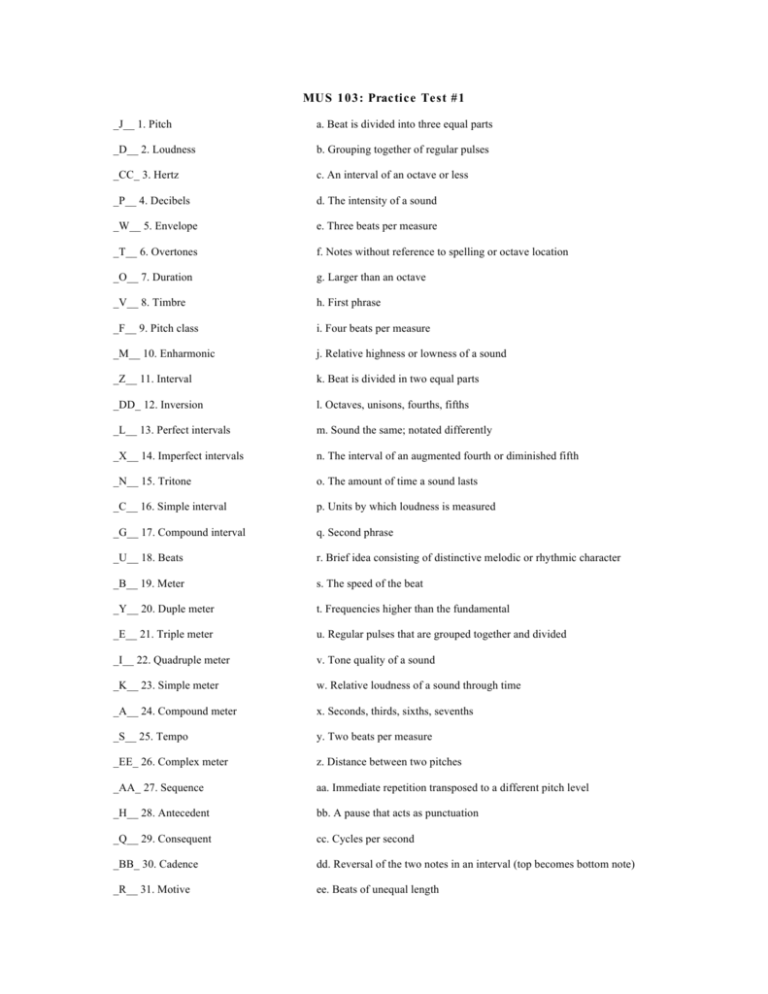
MUS 103: Practice Test #1 _J__ 1. Pitch a. Beat is divided into three equal parts _D__ 2. Loudness b. Grouping together of regular pulses _CC_ 3. Hertz c. An interval of an octave or less _P__ 4. Decibels d. The intensity of a sound _W__ 5. Envelope e. Three beats per measure _T__ 6. Overtones f. Notes without reference to spelling or octave location _O__ 7. Duration g. Larger than an octave _V__ 8. Timbre h. First phrase _F__ 9. Pitch class i. Four beats per measure _M__ 10. Enharmonic j. Relative highness or lowness of a sound _Z__ 11. Interval k. Beat is divided in two equal parts _DD_ 12. Inversion l. Octaves, unisons, fourths, fifths _L__ 13. Perfect intervals m. Sound the same; notated differently _X__ 14. Imperfect intervals n. The interval of an augmented fourth or diminished fifth _N__ 15. Tritone o. The amount of time a sound lasts _C__ 16. Simple interval p. Units by which loudness is measured _G__ 17. Compound interval q. Second phrase _U__ 18. Beats r. Brief idea consisting of distinctive melodic or rhythmic character _B__ 19. Meter s. The speed of the beat _Y__ 20. Duple meter t. Frequencies higher than the fundamental _E__ 21. Triple meter u. Regular pulses that are grouped together and divided _I__ 22. Quadruple meter v. Tone quality of a sound _K__ 23. Simple meter w. Relative loudness of a sound through time _A__ 24. Compound meter x. Seconds, thirds, sixths, sevenths _S__ 25. Tempo y. Two beats per measure _EE_ 26. Complex meter z. Distance between two pitches _AA_ 27. Sequence aa. Immediate repetition transposed to a different pitch level _H__ 28. Antecedent bb. A pause that acts as punctuation _Q__ 29. Consequent cc. Cycles per second _BB_ 30. Cadence dd. Reversal of the two notes in an interval (top becomes bottom note) _R__ 31. Motive ee. Beats of unequal length II. Label the meter type of each example (duple, triple, quadruple; simple, compound) and provide one full measure of beats and divisions for each. Beam divisions where appropriate (20 pts.) j j ? 16 6 œœ . œ œ œœ . œ œ . . . œ. 32 ˙œ œ ˙œ œ ˙œ œ 12 8 œœ œ œ œœ œ œ œœ œ œœœœ j j j j . . . ?9 œ œ œ 4 œ œ œ œ 8 œ œ œ œ œ œ œ œ œ 8 œ œ œ œ œ œ œ œ duple compound triple simple triple compound quadruple simple #œ B œ III. Identify the pitches by letter name and octave classification. (10 pts.) ? bœ B! 2 œ F3 & œ A4 F" 5 bœ G4 A! 3 IV. Identify the intervals by quality and quality. (20 pts.) Be sure to clearly distinguish between M and m in your handwriting. & # ww M2 w bw M6 # # ww P4 #w # w b ww bw w & w bw b ww w w ? #w #w b ww ? m6 M6 m7 quadruple compound m3 m2 P5 m6 m7 b ww A4 B œ E3 œ C3 ww A4 bœ #œ E! 4 G" 3 b b ww P5 w bw M7 ww b ww A4 bw w w #w #w w m7 d5 m6 M6 V. Write the requested intervals above or below the given notes as indicated. (20 pts.) DO NOT CHANGE THE GIVEN NOTES! above: & ? b wœ b wœ M2 #œ # w #œ w b wœ œw m2 m3 # wœ #w #œ M7 bw b œ #w # œ bw bœ m3 above: M6 & ? below: m3 below: # wœ P4 m6 P5 M6 m7 œ #w m6 œ bw M7 # œw m2 wœ M3 œ bw M7 # wœ A4 w œ P5 b b œw M2
